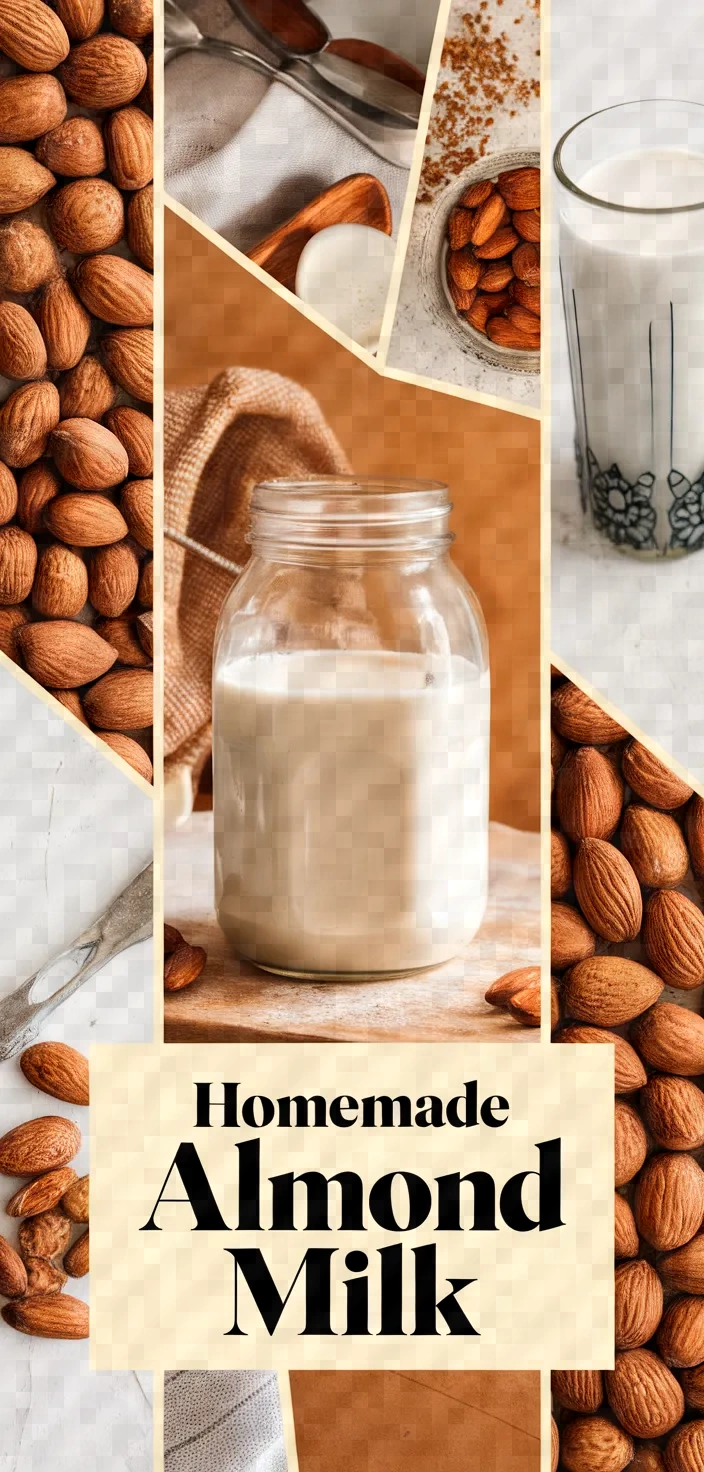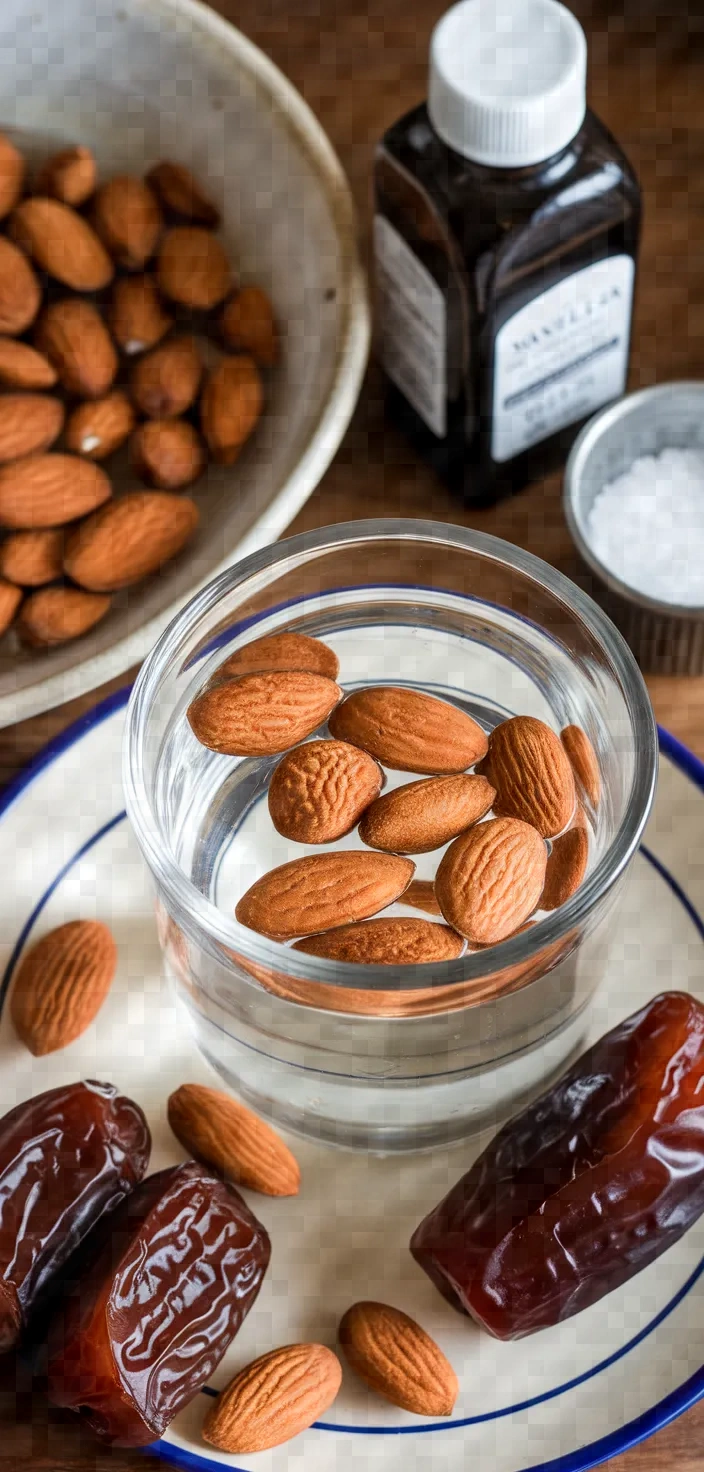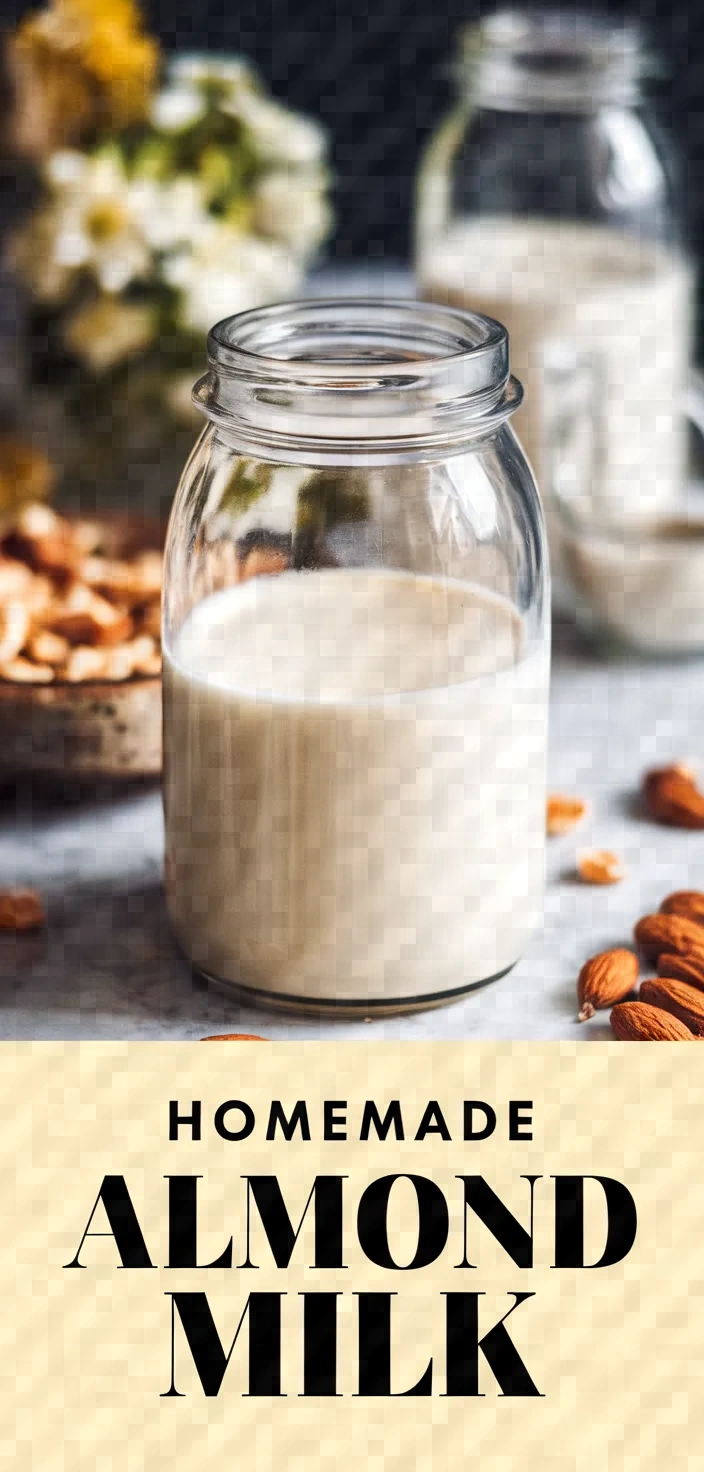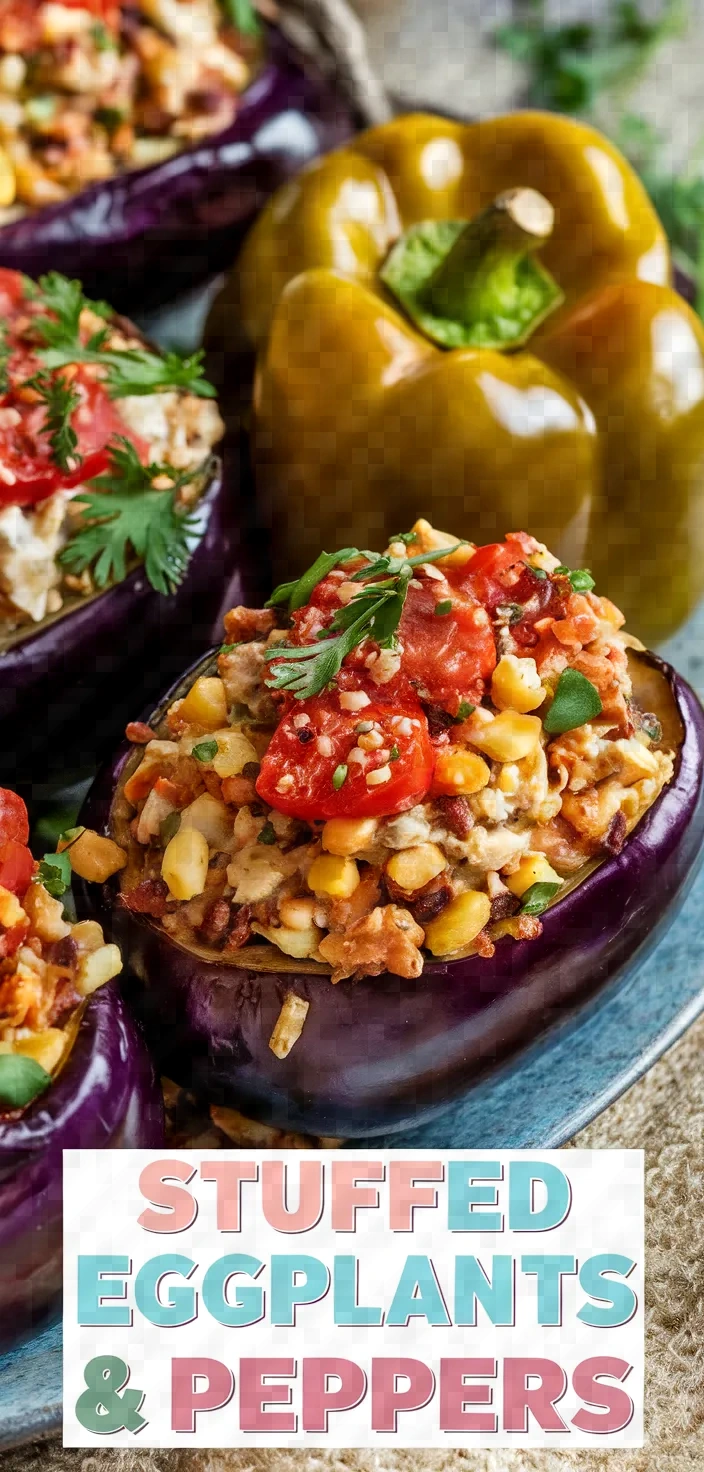Crafting your own almond milk at home feels like the ultimate act of self-care, and trust me, there’s something wonderfully satisfying about blending up a batch of fresh, silky goodness from scratch.

Making almond milk at home is a way to create a simple drink that is safe and nutritious — and devoid of all the weird things that show up in so many commercial nut milks. I was quite taken with the taste of the drink.
The raw almonds I’d blended were the most important factor. They are incredibly nutrient-dense, with a lot of healthy fats and quite a few vitamins packed in there.
Homemade Almond Milk Recipe Ingredients

- Raw Almonds: Rich in vitamin E and magnesium; provide protein and healthy fats.
- Filtered Water: Essential base; hydrates and blends almonds smoothly.
- Medjool Dates: Natural sweetness; high in fiber and antioxidants.
- Vanilla Extract: Aromatic; enhances flavor with a subtle sweetness.
- Pinch of Salt: Balances flavors; enhances natural sweetness.
Homemade Almond Milk Recipe Ingredient Quantities
- 1 cup raw almonds
- 4 cups filtered water
- 1-2 Medjool dates, pitted (optional for sweetness)
- 1 tsp vanilla extract (optional)
- Pinch of salt (optional)
How to Make this Homemade Almond Milk Recipe
1. Put the unroasted almonds in a bowl and cover with water. Let them soak for 8-12 hours or overnight, then drain and rinse well.
2. Mix the 4 cups of filtered water with the soaked almonds in a blender.
3. You may include 1-2 pitted Medjool dates to add sweetness, 1 teaspoon of vanilla extract to enhance flavor, and a pinch of salt for seasoning.
4. Mix at top speed for approximately 1-2 minutes until the almonds are ground to a fine powder and the compound has taken on a smooth, creamy appearance.
5. Place a nut milk bag or several layers of cheesecloth in a bowl.
6. Pour the blended almond mixture slowly into the bowl lined with cloth. Pull the edges of the cloth together to form a closed pouch.
7. Extract as much liquid as possible from the cloth or nut milk bag by squeezing and twisting it, leaving behind the almond pulp.
8. To store the almond milk, pour it into a jar or bottle that can be sealed.
9. Refrigerate for a minimum of one hour before serving to allow the flavors to meld and develop.
10. Refrigerate the almond milk and use it within 3-4 days. It is always best to shake well before pouring any liquid that is prone to separation.
Homemade Almond Milk Recipe Equipment Needed
1. Bowl
2. Blender
3. Measuring cups and spoons
4. Nut milk bag or cheesecloth
5. Spoon or spatula
6. Jar or bottle with a sealable lid
FAQ
- Can I use almonds with the skin on?Certainly! Almonds can be used in their whole form, with the skin still on. Yet, if you want to go the extra mile (and really, it’s not that far), soaking them and then peeling them can yield an almond milk that has an even creamier texture.
- How long should I soak the almonds?It is suggested to soak the almonds for a minimum of 8-12 hours or overnight to soften them and increase nutrient absorption.
- Can I store almond milk at room temperature?Almond milk prepared at home must be refrigerated and is most enjoyable within 3-5 days.
- What can I do with the leftover almond pulp?Baking, smoothies, or using it as a base to make almond flour are some of the ways you can use the almond pulp left over from making almond milk.
- Is there a substitute for Medjool dates?Medjool dates can be replaced with other sweeteners such as maple syrup or honey; you can also leave them out entirely for an unsweetened version of almond milk.
- Can I use a regular blender if I don’t have a high-speed blender?Certainly, a conventional blender might necessitate more time in the operation to secure a uniform texture. On the other hand, if you are considering a hand blender, a good one can puree seamlessly in very little time. Nevertheless, if you are using a normal blender, run it longer than you think you should, then let it sit for a minute and run it a bit more. That’s the trick to getting it all incorporated well.
- Do I need a nut milk bag to strain the milk?For best results, we recommend using a nut milk bag; however, you can also use a fine mesh strainer or cheesecloth.
Homemade Almond Milk Recipe Substitutions and Variations
Creamier milk can be made from raw cashews instead of using raw almonds. Use raw hazelnuts if you prefer a flavor profile that’s more nutty.
Maple syrup or honey can replace Medjool dates to adjust sweetness.
Coconut water can be used in place of filtered water to create a flavor that’s a little more exotic.
Almond extract can be used to replace vanilla extract, but the flavor will be much more intense. This will work in dishes where vanilla is called for but will impart a more nutty and bold flavor.
A tiny amount of salt can be exchanged for an equivalent amount of cinnamon, which would add a nice warmth and spiciness and possibly make the dish seem more adventurous.
Pro Tips
1. Optimize Soaking: To enhance the soaking process, consider adding a teaspoon of salt to the soaking water. This can help break down enzyme inhibitors in the almonds, making them easier to blend and digest.
2. Blending Tips: For an even creamier texture, blend the almonds and water for a little longer, around 3-4 minutes, or blend in batches if your blender is not very powerful. This ensures a thorough breakdown of the almonds, resulting in a smoother milk.
3. Flavor Enhancements: Experiment with additional flavors like cinnamon or nutmeg by adding a pinch to the blender along with vanilla extract. This can add a warm, aromatic profile to the almond milk.
4. Reuse Almond Pulp: Don’t discard the leftover almond pulp. It can be repurposed into baking recipes like muffins, cookies, or granola, or you can dry it out to make almond flour.
5. Alternative Sweeteners: If you prefer not to use dates for sweetness, try adding a spoonful of maple syrup or honey after blending. Adjust sweetness to your personal taste preference.

Homemade Almond Milk Recipe
My favorite Homemade Almond Milk Recipe
Equipment Needed:
1. Bowl
2. Blender
3. Measuring cups and spoons
4. Nut milk bag or cheesecloth
5. Spoon or spatula
6. Jar or bottle with a sealable lid
Ingredients:
- 1 cup raw almonds
- 4 cups filtered water
- 1-2 Medjool dates, pitted (optional for sweetness)
- 1 tsp vanilla extract (optional)
- Pinch of salt (optional)
Instructions:
1. Put the unroasted almonds in a bowl and cover with water. Let them soak for 8-12 hours or overnight, then drain and rinse well.
2. Mix the 4 cups of filtered water with the soaked almonds in a blender.
3. You may include 1-2 pitted Medjool dates to add sweetness, 1 teaspoon of vanilla extract to enhance flavor, and a pinch of salt for seasoning.
4. Mix at top speed for approximately 1-2 minutes until the almonds are ground to a fine powder and the compound has taken on a smooth, creamy appearance.
5. Place a nut milk bag or several layers of cheesecloth in a bowl.
6. Pour the blended almond mixture slowly into the bowl lined with cloth. Pull the edges of the cloth together to form a closed pouch.
7. Extract as much liquid as possible from the cloth or nut milk bag by squeezing and twisting it, leaving behind the almond pulp.
8. To store the almond milk, pour it into a jar or bottle that can be sealed.
9. Refrigerate for a minimum of one hour before serving to allow the flavors to meld and develop.
10. Refrigerate the almond milk and use it within 3-4 days. It is always best to shake well before pouring any liquid that is prone to separation.















